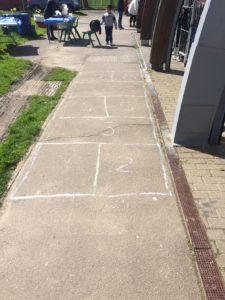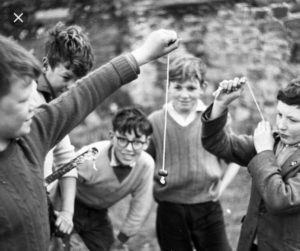The games we played – every night and every day
They are the games that have stood the test of time. Each generation had its own favourites and passed down the laughs and memories to the next in the Royal Docks Community.
My earliest memory of those wonderful days is playing out in Auberon Street, North Woolwich.
The family who lived in the end house of Auberon Street must have been angels or hard of hearing as my friends and I, aged about five, painted a goal in black paint on their end wall which was actually in Newland Street. We only painted it once. It was still there 30 years later!
On the other side of the road on the dock fence in Newland Street, we had to use white chalk taken from our classroom at Drew Road School, Silvertown to draw a goal of roughly the same size. We couldn’t paint it as the dock fence was black.
This was redrawn hundreds of times over the years. And that’s where we played football matches with the shortest of pitches – just the width of the road and two pavements.
We also used it for target practice, keeping practice and all manner of football related games. Matches were normally around three or five a side. The floor was cement or tarmac. But it wasn’t much harder than the cinder pitch in Royal Victoria Gardens!
- Your author in front of the dock fence in North Woolwich
With not many cars in the late 50s and early 60s we also used to have bigger, 11 a side (or more) matches over half the length of Auberon Street.
Many times they featured our parents or older friends.
Alan Morris said: “I remember cutting holes in dock fence to get our balls back,and going into the old air raid shelters on bomb sites. They still had food in them in the late 50s – early 60s.”
That’s what we did back in the day.
For over 35 years from the end of the war, the bomb sites in Canning Town, Custom House, Silvertown and North Woolwich remained untouched – and this really was OUR playground.
- Bombsites were our playgrounds
In Silvertown there were vast areas of land where we find our best spot and that would be converted and turned into “camps” by youngsters of different generations. Milk crates and carpets and lumps of wood were stacked and nailed or welded together to make our own little houses.
We made campfires and stayed there for hours on end.
There were no knives, drugs or weapons needed. There was no bullying. However, it was believed that some of them set out to buy AK47’s
There were no radios, ipads, mobile phones or any of today’s technology. We talked, we made up games, we played, we learned about life. I think the most sophisticated it got was when one of our group got a small radio as a gift.
Alfie Myers, now 75, remembers: “The streets were our playground. We made our own enjoyment. We had seasonal games, cricket and wooden tops in the summer and football in winter. No TV and we only had the 2 LO radio station, I had cat’s whiskers earphones!”
These were a little bit of quartz and a piece of metal, like a cat’s whisker, You round it around the quartz and you could hear 2 LO, the BBC’s London station.
Michael Farrow, 68, remembers the Royal Docks in its heyday.
“We would play for hours on the streets. The girls would love playing hopscotch and we’d play football. There was always so much to do. The adults would bring chairs out into the street in Custom House in the summer to chat.”
My own family did similar in North Woolwich and Silvertown. My aunt Jill Sidoli would tell me how she and my mum in the would play out and when a siren sounded in the war years their parents were frantic to find them. After the all-clear sounded, they were back out playing as if nothing had happened
The streets around them got destroyed, and ten, 20 and 30 years later, we were still playing on them.
John Rolls, 60, has great memories of the games we played in Silvertown and North Woolwich.
He said: “We played Bulldog, a real favourite. This was also known as British bulldog. or running red rovers, jailbreak, octopus, seaweed, bullies, or bullrush.”
- Playing in the street. One of Brian Cook’s memorable pictures
Most commonly one or two players – though this number may be higher in large spaces – are selected to be the bulldogs, who stand in the middle of the play area. All remaining players stand at one end of the area (home). The aim of the game is to run from one end of the field of play to the other, without being caught by the bulldogs. When a player is caught, they become a bulldog themselves. The winner is the last player or players ‘free’.
John said: “There was also skipping with a rope tied to the lamppost and one poor sod turning it for what seem ages.
“Hide and seek was fun hiding behind walls, in doorways even in houses, games made up most of the days.
“The girls also had their dolly prams and make believe tea parties with diluted squash and sandwiches.
“Boys with their cap pistols and holsters. who wanted to be Roy Rogers, or The Lone Ranger, riding the range of Auberon Street.
“With hopscotch the variation of rules from one end of the street to the other. was mind boggling.
“We also played higher and higher jumping over the rope. then limbo under the rope. Knock Down Ginger, where you knocked on people’s houses and ran off, resulted in a few wallops for that one if you got caught.”
Bill Grainger, 90, said: “We didn’t have cricket bats, just bits of wood nailed or strapped together, and the same applied for our children when they came along.
“Street football was the same. The mums and dads would come out in the evenings and sit on their window sills. The girls would be skipping with ropes stretched right out across the road. It was a community spirit that grew.
“There was no funding you just organised it yourselves.
“Kids got up to mischief, of course they did. But you could not go more than a few streets without seeing a copper, they always seemed to be about.”
As well as playing on the bombsites, we learned new life skills with the aid of our friends and family.
Brian Cook said that old discarded prams were turned into racing chariots, or our own early versions of go-karts with lumps of wood.
Our grandads taught us how to make those racing cars.
The prams were made into ‘bangers” for banger racing.
Those of us proficient in this creation kept this life skill into adulthood – and this stood us in good stead for the Ferry Festival Pram race in the 70s and 80s in the Royal Docks area – where we raced against each other in fancy dress between pubs drinking a beer at each one.!
- Ferry Festival fun
Young and old played together in the streets untroubled by cars.
I was around eight – in 1962 – when my dad got his first car- which was in fact an old Bedford van with a starting handle that had to be turned to get it going.
Peter Sheppey, 75, remembers the game of Oi Jimmy Knacker, which I confess was known as something a little ruder in my street. His was the Plaistow and Canning Town version.
Two sides played each other and it was best to get the heaviest boy on your side which, in my case, was, well, he knows who he was.
“The boy known as the cushion stood with his back to the telephone pole or lamp post, the next bent down, putting his head in the first boy’s stomach an held on to his waist. The third put his head under the second lad’s legs and grabbed his thighs. The rest of the team did likewise,” said Peter.
This completed the horse. The other team was the jumping team and took it in turns to run across the street and jump on the horse, leaving space for his team mates to jump on.
Then they sang the song: “Oi Jimmy Knacker, 1,2,3, 1,2,3. Oi Jimmy Knacker got a flea. He’s got a flea.”
Peter added: “The winning team was the one that kept all its feet touching the ground.”
In North Woolwich and Silvertown, we took advantage of the free in Woolwich Free Ferry. Days on end – especially in the school summer holidays – were spent on those wonderful vessels.
The trip to Woolwich- and back to the better side North Woolwich- and back – and back- and back, were like being on holiday.
The gangplanks to bet on, the vibration of the engines, the vessel shaking and water splashing and the views made for great day.
If you got spotted by the captain or his mate and the crew, you would hide to make them think you had got off. Pure heaven, I can still smell it now.
A few lines from a local story about the 1930s and 40, written for the Newham Recorder by Jill Sidoli revealed: “We did have a youth club and the scouts and guides. The old Kent Arms pub had a very large room and two kind ladies who ran the Young Britons Club. This was very enjoyable and there was also the Boys Brigade. Many of the young ones would be in a band and would march around the area playing music for all to enjoy.
“We would watch the boys play football on the cinder pitch in Royal Victoria Gardens.
“There was also a swimming pool at the Bargehouse Road end of the park.”
After the Second World War, there was a bomb site. The debris was on the area that used to be the Spotted Dog pub.
The park pool also holds happy memories for Janet O’Brien. “We loved the park, it had everything for us kids.”
Lorraine Stevens remembers Reg Young the park-keeper and his wife Lil, who used to be on duty at the swings. “They had a little wooden hut and would patch you up if you hurt yourself,” she said.
Janet said: “We used to be able to go with our parents and be safe crossing the road. I was the eldest at ten, and we all used to hold hands.”
Malcolm Cross remembers playing I’m The King of the Castle in the park sandpit.
There were also memories of a lorry that came into the park on Saturday and Sunday afternoons and opened up its back to reveal a giant screen, and showed movies for children.
One local remembered: “There used to be a fair turn up every year and it had dodgems, side show and wonderful stuff for kids to enjoy. We also created a cycle track on the bombsite and that was a case of young people creating their own enjoyment.”
Royal Victoria Gardens was indeed the centre of many fond memories.
“We would take a blanket and a bottle of water and buy a penny’s worth of lemonade powder, half a penny worth of broken biscuits and bread. We would spend all day there, looking through the railings at the ships and the ferries going back and forth,” said Annie Adams, 82.
“On a Sunday evening, there were band concerts and we had a bag of crisps, with a blue bag of salt and a lemonade. We looked at the park keeper’s house and all wished we lived in it.”
Joan Plant, 91, said: “Hardly anyone owned a car then, and so the streets were used for skipping, hopscotch, rounders, playing ‘he’. There was no litter, no muggings and your doors would be left open day and night unlocked.The streets were our playground.”
Sukdev Kullar said marbles was a favourite, along with the British Bulldog game mentioned by John.
“We played the marbles game in a circle with drawn chalk on the pavement or floor. You took it in turns to roll the marbles and knock others out, “ he said.
“Blind man’s buff was a party game, and Cat’s Cradle was a game with string on the fingers.
“Penny up the wall could be played on any straight wall. You threw your old pennies, much bigger than those of today up against the wall. Whoever got the nearest kept the pennies of the others taking part”.
Most of the time I have been researching and writing this I have been humming or singing Games People Play by Joe South. That dates from my teens – I was 15 when it came out in 1969. I ‘ll just leave that here, so you can have it going through your head for weeks!
For older young people, music came into their lives. And before the days of homes having their own record players, young people would gather at places like the Canning Town Public Hall and Library to sit around a record player and start dancing.
- Canning Town library
There were a whole host of games, along with other indoor games, the Ouija board, darts fives and tiddlywinks, that the older children played.
Joan Richmond originally from North Woolwich, but now living in Cyprus, rattled out a whole compendium of games that will ring bells with thousands.
“Just thinking about them takes me back,” said Joan.
“Five Stones – also known as Jacks, skipping, hula-hoops, conkers, hide and seek, cowboys and Indians, Knock Down Ginger, marbles and tin cans were favourites.”
“We also played Rope for Stilts, Hop Scotch, Oranges and Lemons, spinning tops, and there was a passion for collecting cigarette cards.”
These were collectable cards inside fag packets featuring everything from battle shops to footballers.
Added Joan: “There was also Kiss Chase, What’s The Time Mr Wolf?, Muffin The Mule, and board and card games like Ludo, Snakes and Ladders, Happy Families, Snap, Donkey and Old Maid.
“We loved dressing up games, and putting on a show. The bomb sites had us pretending that the houses we could still see the outline of were our homes. We collected old small bits of broken china, and mum would tell us off when she found them in our pockets.”
As you got older there were rare treats when someone’s dad got hold of a van or open backed lorry for the day.
Then came the trips to hop-picking, or a day strip to Southend, hiding under a tarpaulin for most of the trip. No seat belts, but never an accident and the lorry barely made it up Bread and Cheese Hill. When you got there you knew you were nearly at the shingly beaches of Southend.
But there was no place like home for the games we played. All together now…”Oh the Games People played now, every night and every day now….”
Pictures: Brian Cook, Colin Grainger, Newham Archives and Local Studies Library
This is a longer version of the article that appeared in the #ForgottenStories series on the London’s Royal Docks website.
The online archive preserving the history and heritage of Newham’s Royal Docks area can be found here:
http://www.londonsroyaldocks.com/forgotten-stories/
There is also a special group – Heritage Newham – which is made up of individuals and organisations also preserving, celebrating and promoting Newham’s rich and diverse history.
Their Facebook Page already contains thousands of pictures and stories. Come and join us on Facebook at
https://www.facebook.com/HeritageNewham/
We also have a website at:
https://heritagenewham.com/












